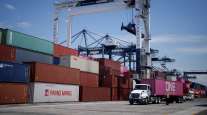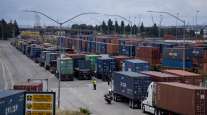Senior Reporter
West Coast Ports Begin Effort to Win Back Business

[Stay on top of transportation news: Get TTNews in your inbox.]
The tentative six-year labor agreement between the International Longshore and Warehouse Union and the Pacific Maritime Association is a major step in addressing a shift of cargo volumes to East Coast ports that has taken place amid uncertainty sparked by the long negotiation process.
“The contract is the single biggest factor to reverse the dramatic shift toward the East and Gulf Coast,” said economist Paul Bingham, director of transportation consulting for S&P Global Market Intelligence. “But some of this lost cargo on the West Coast is never coming back, because the beneficial cargo owners are now relying on trade routes through the Panama Canal or the Suez Canal to reach the East Coast, and they have committed to warehouse and distribution center leases they are not going to abandon.”
Port of Los Angeles Executive Director Gene Seroka on June 13 said the facility through May has seen total container volumes drop 27% year-over-year, and that container volume is running at 15% lower than the five-year average.
“Even with improving volume, our terminals are a long way from working at full capacity,” he said. “We’re starting to see more vessels headed across the Pacific to Los Angeles, an encouraging sign for the second half of the year.”
Port of Los Angeles Executive Director Gene Seroka joined @conanNBCLA on NBC NewsConference Extra to discuss the new tentative labor agreement, importance of moving cargo through West Coast ports, and goal toward zero-emissions. Credit: @NBCLA. https://t.co/4V56pEkdwx — Port of Los Angeles (@PortofLA) June 20, 2023
The Port of Los Angeles is the nation’s busiest port, processing $440 billion in cargo value per year. In May, however, the facility saw a 19% year-over-year drop in cargo volume, processing 779,140 20-foot-equivalent containers, compared with 967,900 in the same period a year ago. The adjacent Port of Long Beach reported a nearly 15% year-over-year decline in May, processing 758,225 containers compared with 890,989 a year ago. Still, that is a 28.2% increase from the 544,104 TEUs the facility moved in December, when shipments reached their lowest level since April 2020.
The 22,000-member ILWU represents workers at 29 ports and warehouses along the West Coast. The tentative deal now heads to the union’s membership for a vote.
Experts noted that while West Coast ports have made structural business changes amid the shift to the East Coast, facilities still must accelerate their efforts in order to return to their pre-pandemic prominence, especially in light of upgrades some East Coast ports are making.
Facilities including the ports of Savannah, Virginia and others are undergoing multibillion-dollar expansion and dredging projects to make the facilities larger and more competitive. The Port of Savannah, for example, is expanding annual TEU capacity from its existing 6 million to 10 million containers by the end of 2026.
Another factor impacting West Coast ports is ongoing uncertainty and long delays with freight rail carriers, including Union Pacific’s June decision to temporarily shut down its inland ramps at Los Angeles and Long Beach. The railroad called the move a proactive measure, noting at the time that the labor talks were dragging on and it wanted to offer shippers other ways to move cargo.
“Many of the larger companies, the larger retailers, have contingency plans,” said Frank Kenney, director of industry solutions with the transportation and logistics provider Cleo. “They’ve levered Savannah, and the top of the Gulf, Port Elizabeth in New Jersey, and spending an extra week in transit going through the Panama Canal [is] working.”
Kenney noted that shippers now realize that the distance, time and cost to get cargo from an East Coast port to the center of the country is often lower than the effort needed to ship to the same area from the West Coast.
Want more news? Listen to today's daily briefing above or go here for more info
But California trucking leaders are bullish about a comeback.
“If we can convince the shippers that this disruption was an anomaly and rebuild the confidence, we’ll be OK,” Harbor Trucking Association CEO Matt Schrap said. “It’s more expensive to come to the West Coast, but we have a tremendous amount of infrastructure. There are a lot of positives, but we’re going to have to work hard to win back the business.”
He added, “We want it and we need it. We want them to have confidence.”




